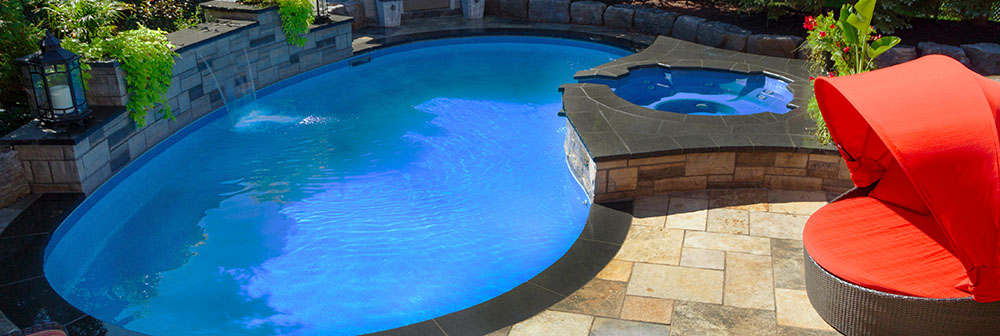Landscaping Tips for Your New Inground Pool

Congratulations on adding a pool to your outdoor space! Once your pool is installed, the next challenge is landscaping. There are a lot of things to consider when landscaping around your inground pool, but when done right you’ll have the perfect focal point for your backyard. Here’s how to get started.
1. Identify your goals
Before you start digging you need to sit down and consider what your goals are. Do you have young children? Do you have pets? Is your pool for exercise, entertainment, lounging, or for the kids? What sort of impression are you trying to make? Do you have a hot tub or spa that will be used all year, or a pool that you’ll use only in the summer?
The answers to these questions will help drive your landscaping, which is opportunity for you to shape your surroundings in a way that is reflective of your own personal needs, wants, vision, and philosophy.
Most people want a landscaping project that:
- Is affordable: A pool is already a major investment, spending thousands of dollars on the right landscaping to compliment it may not be an option for everyone. That said, if you invest in a pool, spending a bit of time and money to make your backyard as beautiful and functional as possible is worth the investment.
- Increases pool privacy: Keeping your pool away from prying eyes is usually considered a high priority by pool owners, especially those with children. Landscaping is a great way to afford yourself some privacy, especially in a busy subdivision. You can plant shrubs and trees, put up a privacy fence, or plant climbing vines along an existing fence to make your space more private.
- Maintains or increases safety: For parents of young children, your landscaping should ensure that you have multiple lines of sight from your home, and around your backyard. It takes less than a minute for a child to drown, so keeping an eye on the kids all the time (even with secure fencing around your pool) should be every parents’ priority.
- Pool friendly: Large leafy trees may make for great privacy, but they also drop leaves, sticks, acorns, and other debris into your pool. Choosing the right types of plants is important. You may want to opt for evergreen trees or shrubs, and you should keep them well back of the pool area to prevent debris from falling into the pool. If you have existing trees or plants that are messy, you may need to consider moving or removing them to help you keep your pool clean.
- Low maintenance: What good is the perfect backyard if you spend all weekend primping, pruning, raking, and mowing? All landscapes require some maintenance, but when you choose plants and ground cover go for low-maintenance options.
- Pet and kid friendly: Roses are red, but they are also covered in thorns. So, although you may love the look of roses, or other prickly plants consider that children and pets may not understand the figurative or literal meaning of “every rose has its thorns.” When searching for plants make sure you stress that you need them to be kid and pet friendly. Many plants like the blue monk look beautiful but are poisonous to humans and/or animals. Avoid these at all costs.
- Matches your home’s style: Taking into consideration the existing style of your home is important. Creating a tropical themed backyard paradise might not gel well with a Victorian style home.
- Safe pool deck: Decks and patios make great lounging areas for swimmers and parents, but remember that the goal is to enhance the pool, not overshadow it. Stone, and stamped concrete provide a natural feel, brick and tile are more contemporary materials, and wooden decks are versatile enough to match any style.
Whether you go with concrete, interlocking brick or a wooden deck, it’s important that the area surrounding your pool is flat and even so that there are no tripping hazards. Some surfaces are more slip-resistant than others, but encourage your children and guests to never run around the pool. Safety first.
2. Know your budget
Once you have identified your goals it is time to start budgeting. You should start the planning process with a clear budget, and be careful not to overspend. Leave some room in the budget for contingencies so that an unexpected cost doesn’t turn your pool landscape project into a money drain.
Plan to do as much work as you can to cut the cost of labour, which will allow you to spend more on materials and plants.
3. Landscape as soon as possible after the installation of your pool
When you installed your pool, your backyard was probably taken apart. This is not always the case, but for many people installing a pool means temporarily removing fences, sheds, gazebos, and even trees, flowerbeds, and turf.
While enjoying a new pool will more than make up for the loss of a few orchids, this is also the ideal opportunity to landscape your property. You’ll find that moving materials in and out of your backyard is much easier when the pool contractors have removed half of your fence! Plus considering the mess that inevitably comes with installing a new pool (even the best contractors can’t prevent it) you will have to do some minor landscaping anyway – so you may as well take full advantage of the opportunity.
4. Should you build a pool shed?
Large additions to your backyard like gazebos, decks, pool sheds, fountains, or statues, may look great in theory, but once you get them into your backyard… maybe not so much. Your pool is the natural focal point, and trying to compete with that is a serious aesthetic faux pas that can turn your backyard oasis into a cluttered mess. Large property owners have much more freedom, but you should still be careful to space out your major items as much as possible.
5. Pick the right plants
We’ve already covered the obvious: don’t plant large leafy plants near the pool, and make sure that you avoid any plants that aren’t kid or dog friendly. You may also want to avoid flowering plants which can trigger allergies, and attract bees which may become a literal pain in the butt to unlucky swimmers. Plants that attract wildlife in general should be discouraged as animals are not familiar with the rules of pool safety and can easily fall in and drown.
Choose plants that are well-suited to your environment, don’t need significant maintenance, provide some privacy and shade, and are hardy enough to survive a busy backyard full of pool goers. Evergreen is the way to go in Ontario.
Having a lawn is a must have for many homeowners, but you should keep it as far from the pool as possible to minimize the amount of grass clippings that end up in the water. Grass is also very susceptible to pool chemicals, so try to keep dripping swimmers off the grass by investing in a stone or concrete path to the pool.
6. Lighting and Shade
Lighting will allow you to accent certain features, but also boosts safety so that dusk, dawn, and nighttime swimmers don’t trip or fall. String patio lights are popular, and LED systems are great for the environment. There are also many solar lights available on the market.
Whatever style you choose it is worth adding in a shaded area (like a gazebo or umbrella) so that when swimmers emerge from the pool they have a place to stay that’s out of the sun. A shaded area is a great place to keep your cooler full of snacks and drinks cool while you’re enjoying the pool.
What’s your next project?
Whether you are installing a new pool, or just looking to transform your property, the right landscaping will make all the difference!
This Blog was Posted on August 28th, 2018
Any Offers, Prices or Product Line Ups Mentioned on this Page are Subject to Change Without Notice


